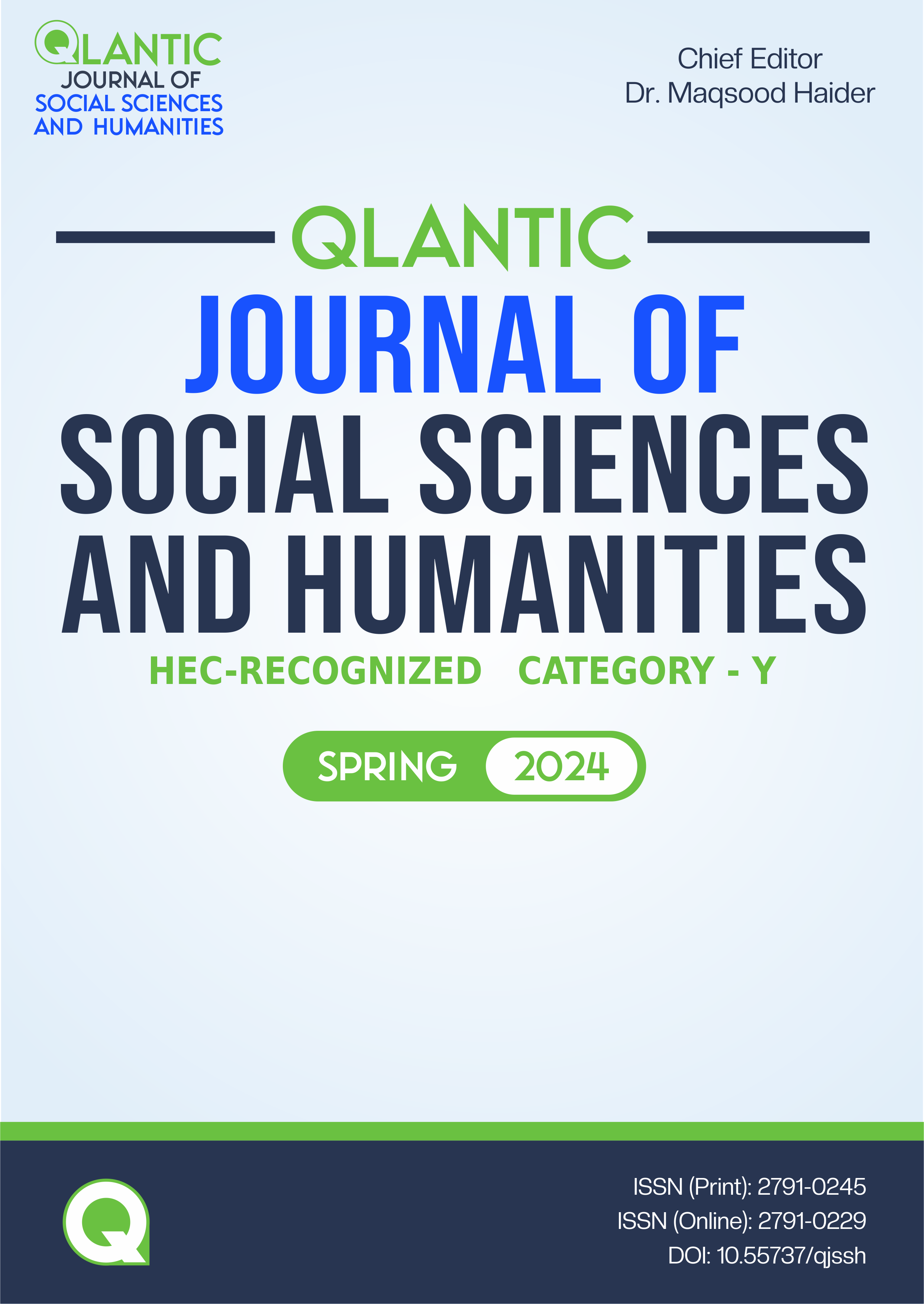Crop and Economic Water Productivity of Wheat at Perennial and Non-Perennial Canals in Sindh
DOI:
https://doi.org/10.55737/qjssh.933349456Keywords:
Crop Water Productivity, Economic Water Productivity, Food SecurityAbstract
The freshwater resources are under immense pressure to provide water and food security. New climate change projections for current and future water availability suggest that farmers and policymakers must move from traditional per-acre crop yield measurement to crop and economics water productivity. This research aimed to assess wheat-crop CWP and EWP at perennial and non-perennial canals. The Nara and Rice canals were selected, and both canals were off-take at Sukkur Barrage from Indus. Two distributaries were selected from each canal with the location of the head and tail. A survey tool was designed to collect data. In total, 431 farmers were randomly selected. The collected data was analyzed by using CWP, EWP, Vw, Cobb-Douglas production function, and DEA techniques. Results show that the tail of the Rice canal, CWP, EWP, and Vw was higher than the head. But at the head of the Nara canal, CWP, EWP, and VW were higher than at the tail. The Cobb-Douglas results show the significant impact of irrigation, fertilizer, and watercourse position on production. Further, in DEA results, the tail reaches of both canals were more efficient. Similarly, higher water-saving potential is observed at the head of both canals.
References
Ahmad, M.-D., Masih, I., & Turral, H. (2004). Diagnostic analysis of spatial and temporal variations in crop water productivity: A field scale analysis of the rice-wheat cropping system of Punjab, Pakistan. Journal of Applied Irrigation Science, 39(1), 43–63.
Bhatti, A. M., Suttinon, P., & Nasu, S. (2009). Agricultural water demand management in Pakistan: A review and perspective. Society for Social Management Systems, 9(172), 1–7. https://citeseerx.ist.psu.edu/document?repid=rep1&type=pdf&doi=927adc73730e433cd0ed73086d45b5e86cc8f0a4
Bouman, B. A. M. (2007). A conceptual framework for the improvement of crop water productivity at different spatial scales. Agricultural Systems, 93(1-3), 43–60. https://doi.org/10.1016/j.agsy.2006.04.004
Brauman, K. A., Siebert, S., & Foley, J. A. (2013). Improvements in crop water productivity increase water sustainability and food security—a global analysis. Environmental Research Letters, 8(2), 1–7. https://doi.org/10.1088/1748-9326/8/2/024030
Control, & Diety, A. M. (2015). World wheat production, maize production, and rice production. www.nue.okstate.edu/Crop_Information/World_Wheat_Production.htm
Dong, B., Loeve, R., Li, Y. H., Chen, C. D., Deng, L., & Molden, D. (2001). Water productivity in the Zhanghe irrigation system: issues of scale. Barker, R., Loeve, 23-25. https://www.watercycle.nl/downloads/chapter6.pdf
Falkenmark, M., & Rockström, J. (2004). Balancing water for humans and nature: the new approach in ecohydrology. Earthscan.
Gleick, P. H. (2002). The World’s Water, 2000-2001: The Biennial Report on Freshwater Resources. Electronic Green Journal, 1(16).
Khan, M. J., Sarwar, T., & Khan, M. J. (2015). Comparative Study of Crop Water Productivity at Farm Level under Public and Civil Canal Irrigation Systems in Peshawar, Pakistan. Sarhad Journal of Agriculture, 31(3), 175–182. https://doi.org/10.17582/journal.sja/2015/31.3.175.182
Kochhar, M. K., Pattillo, M. C. A., Sun, M. Y. M., Suphaphiphat, M. N., Swiston, M. A. J., Tchaidze, M. R., ... & Finger, M. H. (2015). Is the glass half empty or half full?: Issues in managing water challenges and policy instruments. International Monetary Fund.
Koondhar, M. A., Qiu, L., Magsi, H., Chandio, A. A., & He, G. (2018). Comparing economic efficiency of wheat productivity in different cropping systems of Sindh Province, Pakistan. Journal of the Saudi Society of Agricultural Sciences, 17(4), 398–407. https://doi.org/10.1016/j.jssas.2016.09.006
Kumar, M. D., & van Dam, J. C. (2013). Drivers of change in agricultural water productivity and its improvement at basin scale in developing economies. Water International, 38(3), 312–325. https://doi.org/10.1080/02508060.2013.793572
Kuppannan, P., Senthilvel, S., & Ramesh, T. (2009). Water productivity at different scales under canal, tank, and well irrigation systems. IWMI Books, Reports. https://ideas.repec.org/p/iwt/bosers/h042041.html
Malana, N. M., & Malano, H. M. (2006). Benchmarking productive efficiency of selected wheat areas in Pakistan and India using data envelopment analysis. Irrigation and Drainage, 55(4), 383–394. https://doi.org/10.1002/ird.264
Postel, S. (2001). Growing more Food with less Water. Scientific American, 284(2), 46–51. https://doi.org/10.1038/scientificamerican0201-46
Rehman, A., Chandio, A. A., Hussain, I., & Jingdong, L. (2019). Fertilizer consumption, water availability and credit distribution: Major factors affecting agricultural productivity in Pakistan. Journal of the Saudi Society of Agricultural Sciences, 18(3), 269–274. https://doi.org/10.1016/j.jssas.2017.08.002
Rijsberman, F. R. (2006). Water scarcity: fact or fiction?. Agricultural water management, 80(1-3), 5-22.
Shabbir, A., Arshad, M., Bakhsh, A., Usman, M., Shakoor, A., Ahmad, I., & Ahmad, A. (2012). Apparent and real water productivity for cotton-wheat zone of Punjab, Pakistan. Pak. J. Agri. Sci, 49(3), 357-363. https://pakjas.com.pk/papers/2070.pdf
Shafiq, M., & Rehman, T. (2000). The extent of resource use inefficiencies in cotton production in Pakistan’s Punjab: an application of Data Envelopment Analysis. Agricultural Economics, 22(3), 321–330. https://doi.org/10.1111/j.1574-0862.2000.tb00078.x
UNESCO. (2006). The 2nd UN World Water Development Report: “Water, a Shared Responsibility.
Van Dam, J. C., & Malik, R. S. (2003). Water productivity of irrigated crops in Sirsa district, India. http://edepot.wur.nl/24338
WBCSD, W. (2006). Water: Facts and Trends (Vol. 2). World Business Council for Sustainable Development.
Published
Issue
Section
License
Copyright (c) 2024 Zain ul Abdin, Muhammad Ali, Rafique Chandio, Ali Raza Zaidi

This work is licensed under a Creative Commons Attribution-NonCommercial 4.0 International License.





